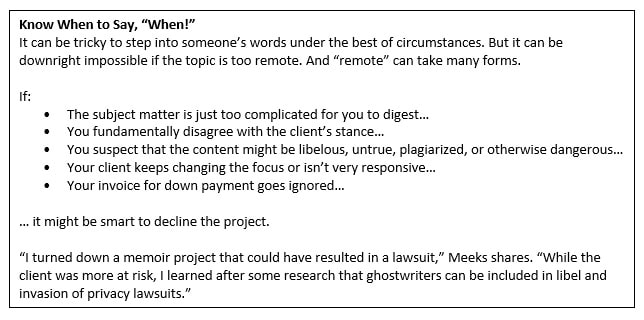
The Art of Ghostwriting: How to Capture Someone Else’s Personality in Your Words
THE ART OF GHOSTWRITING: HOW TO CAPTURE SOMEONE ELSE’S PERSONALITY IN YOUR WORDS
Writing is a very personal process. Every writer is unique, just as every individual is unique.
So how can you write for someone else?
Your goal is authenticity: to genuinely mimic the client’s rhythms and seamlessly weave their characteristics into the story. That is the key to successful ghostwriting.
It’s not enough to be a strong writer, to organize thoughts into a coherent argument, to craft compelling copy that draws the reader. Being a strong ghostwriter means you are also able find the words that capture someone else’s voice and convey another’s personality.
Become a confidante.
Establishing a rapport with your client is crucial to writing from their perspective. And this is no small feat.
As ghostwriter Dana Robinson points out, “You need to achieve a level of confidence most people reserve for close personal friends, but you have to do it in a matter of hours or days.”
Her tack during in-person interviews is to maintain eye contact when the client is talking, never show shock or disgust, and always respond with empathy and understanding.
“The interview is about the client, so I don’t assert too much of my own life into the conversation – but I find that it does help to occasionally throw in a fact or two about myself, especially if it shows that I have an understanding of what they are talking about, a commonality between us.”
Ask the probing questions.
Robinson has noticed that most people like to talk about themselves, especially with their ghostwriter who is an interested captive audience. So it’s typically not hard to get them to share things — after all, the project was their idea. The challenge she faces is getting them to share the right things.
“It’s easy to collect all of the facts; the who, what, when, and where — but it’s the why and the how that I really want,” Robinson says. “Getting at the heart of someone’s story — what they were thinking, what their motivations were — usually takes a lot of direct questions.”
Ghostwriter Flori Meeks agrees. She prepares interview questions in advance that start off easy before getting to subjects that require more sharing and trust on the interviewee’s part.
“If the interviewee is my client, they’re usually receptive to sharing because the project was their idea. I have interviewed friends, colleagues and family members of clients, though, who’ve felt a bit awkward, like they didn’t have anything interesting to offer,” Meeks says. “Sometimes asking the same question a different way helps. Or, I ask very specific questions that might spark a memory or story.”
Getting to the heart of the matter can be difficult, especially for a very personal or complicated story. Even a verbose talker can get tongue-tied.
“If a client suddenly clams up, it usually means we’ve brushed up against a subject they don’t really want to talk about. I remind them they are in control of what goes in and what stays out of the story, then move on to a different subject.”
More often than not, her clients end up returning to those sensitive topics because they feel comfortable confiding in her.
“That is always beneficial, even if the material is not ultimately included in the book. The more we know about our clients, the more we understand what their inner voices sound like, the better we will be able to capture it on paper.”
Meeks says it’s also important to tailor your approach to each interviewee.
“I try to get a feel for their personality and the type of behavior that will put them most at ease, whether that’s being friendly, outgoing and joking around or being subdued and more focused on the subject matter,” Meeks says. “I also try to make interviewees feel respected by listening carefully to their responses and developing follow-up questions based on their answers.”
Ghostwriter Stephanie Hashagen has found that being flexible is key.
“If the questions you have prepared aren’t working, it’s totally fine to go ‘off script’ and let them lead the conversation for a while if that helps,” Hashagen says. “If you’re working on a personal/family project, another thing that can help is photos: It’s amazing how going through old photos can get people to open up.”
Listen actively.
When you’re interviewing your client, or simply chatting over the phone, pay close attention to their words. Are there idioms they use often (even if they use them incorrectly)? Do they have a strong vocabulary? Are there little fixations they seem to come back to? Do you notice particular regional affectations? Embrace their signature phrases – especially the ones you don’t actually use yourself – and make sure to find places for them in the manuscript.
“Even if they repeat themselves, or use filler words, or start and stop and go off on tangents, I try to capture it all because that’s where you can really figure out makes them sound like them,” Hashagen says. “Do they have certain expressions they use all the time? Certain speech patterns unique to them?”
It’s really hard to be an active listener when you’re furiously scribbling notes, though. Make it easier on yourself, and record everything!
You can’t anticipate when your client will share a pearl of wisdom or utter the catchphrase that will tie their story together. To capture their exact words, be sure you record every conversation with them. (But ALWAYS, ALWAYS let them know you are recording.)
Robinson has a process to, literally, capture her client’s voice. She records all of their encounters, then listens to those interviews and transcribes them before writing an outline.
“By the time I begin the actual writing process, I have a fairly strong memory of their accent, cadence, manner, level of formality, etc., and I try to hear them speaking the words that I write,” she says. “Occasionally a client will want something a little bit different, but most often, if I can ‘hear’ them saying it in my head, I know I’m close to the right voice.”
Do your research.
Your client wants to create fresh content. So find out what, if anything, has already been written on the subject they want you to write about. If their thesis ends up mirroring another work, brainstorm with them to develop creative ways to personalize it or add a unique spin based on their personal experience and perspective. Sometimes this process can show them that what they thought their argument was is not actually what they want to argue, after all.
Has your client personally written anything? Even a diary or blog can provide invaluable insight about their life and opinions that can shape and build their story. If they have a favorite book or magazine, what draws them in? Likewise, if there’s a work that turned them off, what specifically repelled them?
In fact, two of Hashagen’s favorite interview questions are, “If your book could sound like any book, what book would you pick?” and “If you could sound like any writer, who would you choose?”
Knowing their likes and dislikes can help structure their project.
Understand your client’s goal for writing the book and who the anticipated readers will be. This often dictates the desired tone. Conversational? Professorial? Academic? Professional? Is there a particular style guideline? Many clients won’t care about adhering to a specific style guide (heck, most won’t know what you’re even asking!). But if your client is publishing work for a very specific sector or niche, there might be an expectation to follow that industry standard.
Provide a litmus test.
Before you get very far into the writing process, ask your client to review a segment. It could be a paragraph, a page, a chapter… whatever best conveys your proposed tone, voice, and focus. Be sure your client is comfortable with the flow of the copy: Can they “hear” themselves in your words? Do they agree it “sounds” like them? Are there phrases that they just can’t hear themselves saying or passages that they feel stray from their goal?
Teena Lyons, aka “Professional Ghost,” shares a tip: “As I often tell clients I work with, the idea is that if their best friend, or close colleague, read their book, they’d never suspect that it was penned by another. If a ghostwriter achieves this goal, they’ve done a great job.”
Be true to your subject, both the topic and client. Don’t add your own spin, and keep the ideas authentic to the client. Remember, this is someone else’s point of view. This can also be helpful to keep in mind if you’re asked to ghostwrite an opinion piece you disagree with.
Meeks and Hashagen feel fortunate that their ghostwriting projects have not typically involved contentious viewpoints that they strongly oppose — but that’s not to say they’ve agreed 100% with the stance of their clients. They employ a similar strategy for writing things that contradict their own opinions.
“When I write the chapter that includes those comments, I focus on the fact they were being expressed as that person’s opinion,” says Meeks.
Hashagen reminds herself, “My job is simply to help this person get their message across clearly, and I do my best to put on my ‘neutral/objective journalist’ hat.”
“Bear in mind that it’s going to be published under their byline,” Emma Brudner, the director of the HubSpot Blog team, reminds us. “Your opinion is moot, and therefore should be mute.”
Your role as the ghostwriter requires the flexibility to adapt — you can (and should!) provide advice when you feel strongly about a decision, but ultimately it’s all up to the client.
Related Content
- 2 Comments
Subscribe to Newsletter
- How Can SharePoint Be Used To Organize and Disseminate SOPs?
- Planning the Perfect Genealogy Research Trip: A Step-by-Step Guide
- From Silly to Awesome: How Words Change Meaning Over Time
- The Psychology of Font Choice: How Typography Impacts Content Engagement
- How to Distribute SOPs for Maximum Usability








2 thoughts on “The Art of Ghostwriting: How to Capture Someone Else’s Personality in Your Words”
I am looking for a woman ghostwriter to assist my 95 year old mother who lives in Naples, Florida.
A woamn in FL would be the best.
Hi Jennifer,
We would love to talk to you about ghostwriting a book for your mother! Please feel free to give us a call at 713-465-6860, or email [email protected]. You can also submit an inquiry through our “contact” page: https://www.thewritersforhire.com/contact/.
We look forward to hearing from you!